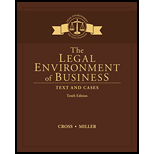
(a)
Case summary: Person B owned a single-family residential lot in the county. The lot was adjacent to the railway road and the county acquired the right to the way from the railroad. The predecessor of B’s property had constructed the fence and shed on the railway road. The county court ordered him to remove the fence and the shed because it disturbed the right of way. He argued in the appellate court that the fence had been in the way for the last twenty years. The appellate court ultimately concluded the case that B had a credible claim for adverse possession. After, the appellate court reversed its decision.
To find: Parties and the conflict in the given case.
(b)
Case summary: Person B owned a single-family residential lot in the county. The lot was adjacent to the railway road and the county acquired the right to way from the Railroad. The predecessor of B’s property had constructed the fence and shed on the railway road. The county court ordered him to remove the fence and shed because it disturbed the right of way. He argued in the appellate court that the fence had been in the way for the last twenty years. The appellate court ultimately concluded the case that B had a credible claim for adverse possession. After, the appellate court reversed its decision.
To find:Requirement of the rule of law on which the outcome of the case depends.
(c)
Case summary: Person B owned a single-family residential lot in the county. The lot was adjacent to the railway road and the county acquired the right to the way from the railroad. The predecessor of B’s property had constructed the fence and shed on railway road. The county court ordered him to remove the fence and shed because it disturbed the right of way. He argued in the appellate court that the fence had been in the way for the last twenty years. The appellate court ultimately concluded the case that B had a credible claim for adverse possession. After, the appellate court reversed its decision.
To find:Exception to the rule and its non-applicability in the given case.
(d)
Case summary: A person B owned a single-family residential lot in the county. The lot was adjacent to the railway road. Three years later, the county acquired the railway road for the right to way and established the hiker bike route. The previous owner of B’s lot had constructed the fence and shed on the railway road. The county court ordered him to remove the fence and shed because it disturbed the right of way. He argued in the appellate court that the fence had been in the right of way for the last twenty years. The appellate court ultimately concluded the case that B had a credible claim for adverse possession. After, the appellate court reversed its decision.
To find: The judgment by applying the rule of law.
Want to see the full answer?
Check out a sample textbook solution
Chapter 26 Solutions
The Legal Environment of Business: Text and Cases (MindTap Course List)
- Can you help me solve this general accounting question using the correct accounting procedures?arrow_forwardWhat gain or loss on disposal should be recorded ?arrow_forwardI need help! Which market is used for trading newly issued securities?A. Secondary marketB. Money marketC. Primary marketD. Derivatives marketarrow_forward
- Vuitton Manufacturing uses a predetermined overhead rate of $38 per machine hour. Estimated machine hours at the beginning of the year were 22,000 and actual machine hours at the end of the year were 23,200. Estimated total manufacturing overhead costs at the beginning of the year are $836,000 and actual total manufacturing overhead costs at the end of the year are $865,000. What is the amount of manufacturing overhead that would have been applied to all jobs during the year?arrow_forwardThe records for valley home supplies showed the followingarrow_forwardWhich market is used for trading newly issued securities?A. Secondary marketB. Money marketC. Primary marketD. Derivatives marketarrow_forward
- I need answer! A higher beta in a stock indicates:A. Lower volatilityB. Higher volatilityC. No riskD. Stable returnarrow_forwardA higher beta in a stock indicates:A. Lower volatilityB. Higher volatilityC. No riskD. Stable returnarrow_forwardWhat is the annual straight-line depreciation amountarrow_forward
 Purchasing and Supply Chain ManagementOperations ManagementISBN:9781285869681Author:Robert M. Monczka, Robert B. Handfield, Larry C. Giunipero, James L. PattersonPublisher:Cengage Learning
Purchasing and Supply Chain ManagementOperations ManagementISBN:9781285869681Author:Robert M. Monczka, Robert B. Handfield, Larry C. Giunipero, James L. PattersonPublisher:Cengage Learning
